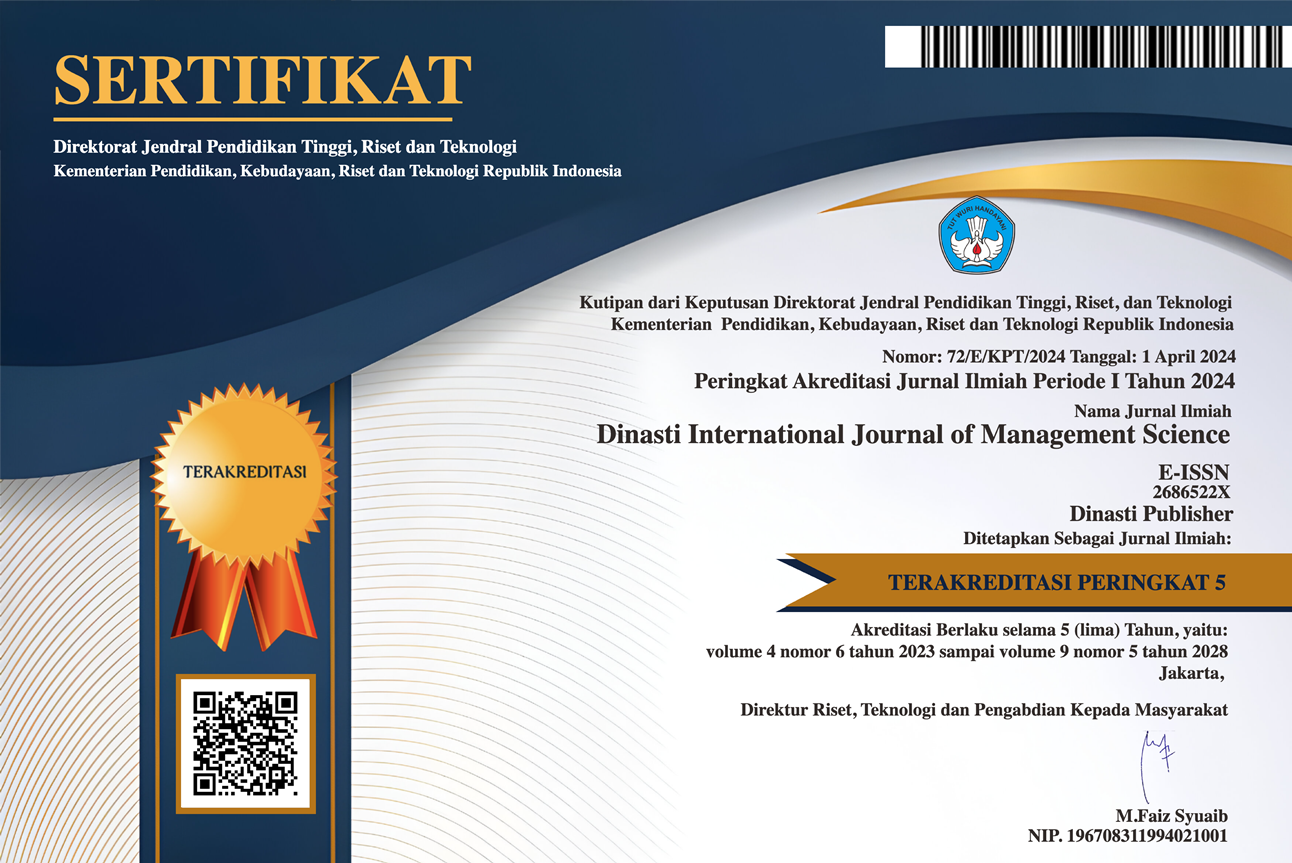Understanding Customer Intention to Use Online Food Delivery Services In The Post-Pandemic Era In Indonesia
DOI:
https://doi.org/10.31933/dijms.v5i3.2365Keywords:
Online Food Delivery (OFD) Services, Attitude, Intention to useAbstract
This study aims to explore the factors influencing consumer attitudes and intentions towards using Online Food Delivery (OFD) services in Indonesia. Integrating the Unified Theory of Acceptance and Use of Technology (UTAUT) and the Theory of Planned Behavior (TPB), the research evaluates dimensions such as performance expectancy, effort expectancy, social influence, information quality, price-saving, and time-saving orientation. Through a structured online survey of 275 Indonesian respondents, it was found that social influence, price-saving, and time-saving orientation positively impact OFD perceptions. This study provides novel insights into post-COVID-19 pandemic OFD research in Indonesia, albeit limited to respondents in the Jabodetabek area.
References
Ajzen, I. (1991, December). The theory of planned behavior. Organizational Behavior and Human Decision Processes, 50(2), 179–211. https://doi.org/10.1016/0749-5978(91)90020-t
Ajzen, I. (2002), “Perceived behavioral control, self-efficacy, locus of control, and the theory of planned behavior”, Journal of Applied Social Psychology, Vol. 32 No. 4, pp. 665-683.
Ajzen, I. and Madden, T.J. (1986), “Prediction of goal-directed behavior: attitudes, intentions, and perceived behavioral control”, Journal of Experimental Social Psychology, Vol. 22 No. 5, pp. 453-474.
Alaimo, L.S., Fiore, M. and Galati, A. (2020), “How the covid-19 pandemic is changing online food shopping human behavior in Italy”, Sustainability, Vol. 12 No. 22, p. 9594, doi: 10.3390/ su12229594.
Alalwan, A.A., Dwivedi, Y.K., Rana, N.P. and Algharabat, R. (2018), “Examining factors influencing Jordanian customers’ intentions and adoption of internet banking: extending UTAUT2 with risk”, Journal of Retailing and Consumer Services, Vol. 40, pp. 125-138.
Ali, I., Rehman, K.U., Yilmaz, A.K., Nazir, S. and Ali, J.F. (2010), “Effects of corporate social responsibility on consumer retention in the cellular industry of Pakistan”, African Journal of Business Management, Vol. 4 No. 4, pp. 475-485.
Allah Pitchay, A., Ganesan, Y., Zulkifli, N. S., & Khaliq, A. (2021, July 20). Determinants of customers’ intention to use online food delivery application through smartphone in Malaysia. British Food Journal, 124(3), 732–753. https://doi.org/10.1108/bfj-01-2021-0075
Chang, H.-H. and Meyerhoefer, C. (2020), “COVID-19 and the Demand for Online Food Shopping Services: Empirical Evidence from Taiwan”, NBER Working Papers 27427, National Bureau of Economic Research.
Chen, C. C., Leon, S., & Nakayama, M. (2018). Converting music streaming free users to paid subscribers: social influence or hedonic performance. International Journal of Electronic Business, 14(2), 128. https://doi.org/10.1504/ijeb.2018.094870
Chiu, C., Wang, E. T. G., Fang, Y., & Huang, H. (2012). Understanding customers’ repeat purchase intentions in B2C e-commerce: the roles of utilitarian value, hedonic value and perceived risk. Information Systems Journal, 24(1), 85–114. https://doi.org/10.1111/j.1365-2575.2012.00407.
Escobar-Rodriguez, T. and Carvajal-Trujillo, E. (2014), “Online purchasing tickets for low cost carriers: an application of the unified theory of acceptance and use of technology (UTAUT) model”, Tourism Management, Vol. 43, pp. 70-88.
Fanoberova, A. and Kuczkowska, H. (2016), “Effects of source credibility and information quality on attitudes and purchase intentions of apparel products”, Master’s thesis, Ume#a School of Business and Economics, available at: https://umu.diva- portal.org/smash/get/diva2:946730/ FULLTEXT01.pdf.
Fishbein, M. and Ajzen, I. (1975), “Belief, attitude, intention, and behavior: an introduction to theory and research”, Philosophy and Rhetoric, Vol. 10 No. 2, pp. 177-188.
Fiske, S.T. and Taylor, S.E. (1991) Social Cognition. 2nd Edition, McGraw-Hill, New York. - References - Scientific Research Publishing. (n.d.). https://www.scirp.org/(S(i43dyn45teexjx455qlt3d2q))/reference/ReferencesPapers.aspx?ReferenceID=2168657
Freeze, R.D., Alshare, K.A., Lane, P.L. and Wen, H.J. (2019), “IS success model in e-learning context based on students’ perceptions”, Journal of Information Systems Education, Vol. 21 No. 2, p. 4.
Galati, A., Crescimanno, M., Vrontis, D. and Siggia, D. (2020), “Contribution to the sustainability challenges of the food-delivery sector: finding from the Deliveroo Italy case study”, Sustainability, Vol. 12 No. 17, p. 7045, doi: 10.3390/su12177045.
Gao, X., Shi, X., Guo, H. and Liu, Y. (2020), “To buy or not buy food online: the impact of the COVID-19 epidemic on the adoption of e-commerce in China”, PloS One, Vol. 15 No. 8, pp. 1-14.
Ghasemaghaei, M. and Hassanein, K. (2019), “Dynamic model of online information quality perceptions and impacts: a literature review”, Behaviour and Information Technology, Vol. 38 No. 3, pp. 302-317.
Gopi, M., & Ramayah, T. (2007). Applicability of theory of planned behavior in predicting intention to trade online. International Journal of Emerging Markets, 2(4), 348–360. https://doi.org/10.1108/17468800710824509
Hair, J.F. Jr, Hult, G.T.M., Ringle, C.M. and Sarstedt, M. (2017), A Primer on Partial Least Squares Structural Equation Modeling (PLS-SEM), 2nd ed., Sage, Thousand Oaks.
Hamid, S., Azhar, M., & Sujood, N. (2022). Behavioral intention to order food and beverage items using e-commerce during COVID-19: an integration of theory of planned behavior (TPB) with trust. British Food Journal, 125(1), 112–131. https://doi.org/10.1108/bfj-03-2021-0338
Hansen, T., Jensen, J.M. and Solgaard, H.S. (2004), “Predicting online grocery buying intention: a comparison of the theory of reasoned action and the theory of planned behavior”, International Journal of Information Management, Vol. 24 No. 6, pp. 539-550.
Henseler, J., Ringle, C.M. and Sarstedt, M. (2015), “A new criterion for assessing discriminant validity in variance-based structural equation modeling”, Journal of the Academy of Marketing Science, Vol. 43 No. 1, pp. 115-135.
Hwang, J., Lee, J. S., & Kim, H. (2019). Perceived innovativeness of drone food delivery services and its impacts on attitude and behavioral intentions: The moderating role of gender and age. International Journal of Hospitality Management, 81, 94–103. https://doi.org/10.1016/j.ijhm.2019.03.002
Internet and social media users in the world 2023 | Statista. (2023, May 22). Statista. https://www.statista.com/statistics/617136/digital-population-worldwide/
Jensen, J. M. (2011). Shopping orientation and online travel shopping: The role of travel experience. International Journal of Tourism Research, 14(1), 56–70. https://doi.org/10.1002/jtr.835
Jung, K., Cho, Y.C. and Lee, S. (2014), “Online shoppers’ response to price comparison sites”, Journal of Business Research, Vol. 67 No. 10, pp. 2079-2087.
Karulkar, Yashodhan & Pahuja, Japmman & Uppal, Balvinder Singh & Sayed, Sarim. (2021). Examining UTAUT model to explore consumer adoption in Online Food Delivery (OFD) services. Pramana.
Khechine, H., Lakhal, S., Pascot, D. and Bytha, A. (2014), “UTAUT model for blended learning: the role of gender and age in the intention to use webinars”, Interdisciplinary Journal of E-Skills and Lifelong Learning, Vol. 10, pp. 033-052, doi: 10.28945/1994.
Lee, E. Y., Lee, S. B., & Jeon, Y. J. J. (2017). Factors influencing the behavioral intention to use food delivery apps. Social Behavior and Personality, 45(9), 1461–1473. https://doi.org/10.2224/sbp.6185
Mathieson, K. (1991), “Predicting user intentions: comparing the technology acceptance model with the theory of planned behavior”, Information Systems Research, Vol. 2 No. 3, pp. 173-191.
Okumus, B., Ali, F., Bilgihan, A. and Ozturk, A.B. (2018), “Psychological factors influencing customers’ acceptance of smartphone diet apps when ordering food at restaurants”, International Journal of Hospitality Management, Vol. 72, pp. 67-77.
Oliveira, T., Faria, M., Thomas, M.A. and Popovic, A. (2014), “Extending the understanding of mobile banking adoption: when UTAUT meets TTF and ITM”, International Journal of Information Management, Vol. 34 No. 5, pp. 689-703.
Palau-Saumell, R., Matute, J., Derqui, B. and Meyer, J.-H. (2021), “The impact of the perceived risk of COVID-19 on consumers’ attitude and behavior toward locally produced food”, British Food Journal, Vol. 123 No. 13, pp. 281-301.
Piroth, P., Ritter, M.S. and Rueger-Muck, E. (2020), “Online grocery shopping adoption: do personality traits matter?”, British Food Journal, Vol. 122 No. 3, pp. 957-975.
Pitchay, A. A., Ganesan, Y., Zulkifli, N. S., & Khaliq, A. (2021). Determinants of customers’ intention to use online food delivery application through smartphone in Malaysia. British Food Journal, 124(3), 732–753. https://doi.org/10.1108/bfj-01-2021-0075
Poon, W. C., & Tung, S. E. H. (2022). The rise of online food delivery culture during the COVID-19 pandemic: an analysis of intention and its associated risk. European Journal of Management and Business Economics. https://doi.org/10.1108/ejmbe-04-2021-0128
Pozzebon, M. (2003). Future of information systems. In Elsevier eBooks (pp. 391–401). https://doi.org/10.1016/b0-12-227240-4/00075-7
Ray, A., Dhir, A., Bala, P.K. and Kaur, P. (2019), “Why do people use food delivery apps (FDA)? A uses and gratification theory perspective”, Journal of Retailing and Consumer Services, Vol. 51, pp. 221-230.
Rese, A., Schreiber, S. and Baier, D. (2014), “Technology acceptance modeling of augmented reality at the point of sale: can surveys be replaced by an analysis of online reviews?”, Journal of Retailing and Consumer Services, Vol. 21 No. 5, pp. 869-876.
Saad, A. T. (2020). Factors affecting online food delivery service in Bangladesh: an empirical study. British Food Journal, 123(2), 535–550. https://doi.org/10.1108/bfj-05-2020-0449
Shaikh, A.A., Glavee-Geo, R. and Karjaluoto, H. (2018), “How relevant are risk perceptions, effort, and performance expectancy in mobile banking adoption?”, International Journal of E-Business Research (IJEBR), Vol. 14 No. 14(2), pp. 39-60.
Statista. (2023). Mobile internet usage worldwide | Statista Market forecast. https://www.statista.com/statistics/617136/digital-population-worldwide/
Statista. (2023). Online Food Delivery - Indonesia | Statista Market forecast. https://www.statista.com/outlook/dmo/online-food-delivery/indonesia
Swaid, S.I. and Wigand, R.T. (2009), “Measuring the quality of e-service: scale development and initial validation”, Journal of Electronic Commerce Research, Vol. 10 No. 1, pp. 13-28.
Tolstoy, D., Nordman, E. R., Hånell, S. M., & Özbek, N. (2021). The development of international e-commerce in retail smes: An effectuation perspective. Journal of World Business, 56(3), 101165. https://doi.org/10.1016/j.jwb.2020.101165
Troise, C., O’Driscoll, A., Tani, M. and Prisco, A. (2021), “Online food delivery services and behavioural intention – a test of an integrated TAM and TPB framework”, British Food Journal, Vol. 123 No. 2, pp. 664-683, doi: 10.1108/BFJ-05-2020-0418.
Venkatesh, V., Morris, M.G., Davis, G.B. and Davis, F.D. (2003), “User acceptance of information technology: toward a unified view”, MIS Quarterly, pp. 425-478.
Venkatesh, V. (2012, February 9). Consumer Acceptance and use of Information technology: Extending the unified theory of acceptance and use of technology. https://papers.ssrn.com/sol3/papers.cfm?abstract_id=2002388
Widayat, W. and Arifin, Z. (2020), “Attitude and behavior on daily food purchasing decisions in the time of COVID-19: a case study of Indonesia consumers”, Jurnal Inovasi Ekonomi, Vol. 5 No. 2, pp. 37-44.
Wu, S. (2003). The relationship between consumer characteristics and attitude toward online shopping. Marketing Intelligence & Planning, 21(1), 37–44. https://doi.org/10.1108/02634500310458135
Yeo, V.C.S., Goh, S.K. and Rezaei, S. (2017), “Consumer experiences, attitude and behavioral intention toward online food delivery (OFD) services”, Journal of Retailing and Consumer Services, Vol. 35 December, pp. 150-162, doi: 10.1016/j.jretconser.2016.12.013.
Yusoff, M.H., Amayreh, K.T., Ismail, R.C., Hatamleh, A., Karim, R., Mohamed, R.R. and El-Ebiary, Y.A.B. (2021), “Food and beverage in Covid-19, shopee in online shop Brooklyn. Store”, Annals of the Romanian Society for Cell Biology, Vol. 25 No. 4, pp. 7746-7753.
Zhou, J., Rau, P. P., & Salvendy, G. (2013). Older adults’ use of smart phones: an investigation of the factors influencing the acceptance of new functions. Behaviour & Information Technology, 33(6), 552–560. https://doi.org/10.1080/0144929x.2013.780637
Downloads
Published
How to Cite
Issue
Section
License
Copyright (c) 2024 Cliff Adam Sugiharto, Himawati Cahyu Lestari, Ishmael Lamisi Kananda, Fadhil Ramadhan, Syifa Salsabila

This work is licensed under a Creative Commons Attribution 4.0 International License.
Authors who publish their manuscripts in this journal agree to the following conditions:
- The copyright on each article belongs to the author(s).
- The author acknowledges that the Dinasti International Journal of Management Science (DIJMS) has the right to be the first to publish with a Creative Commons Attribution 4.0 International license (Attribution 4.0 International (CC BY 4.0).
- Authors can submit articles separately, arrange for the non-exclusive distribution of manuscripts that have been published in this journal into other versions (e.g., sent to the author's institutional repository, publication into books, etc.), by acknowledging that the manuscript has been published for the first time in the Dinasti International Journal of Management Science (DIJMS).
















































